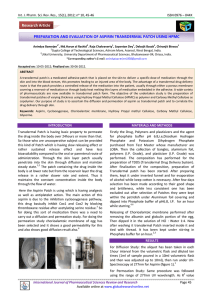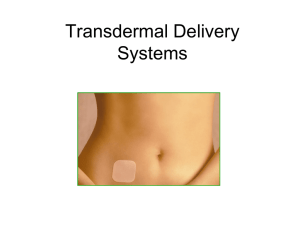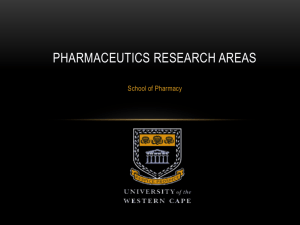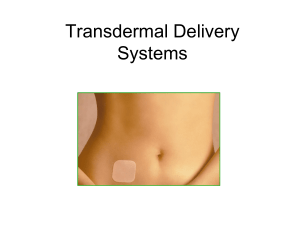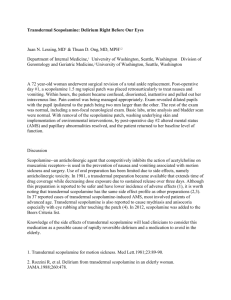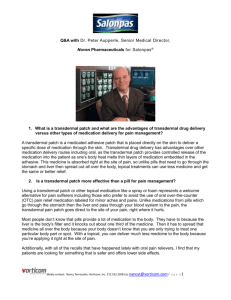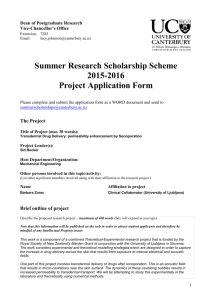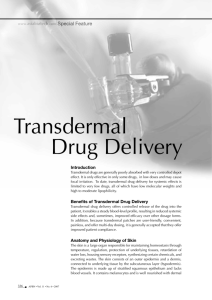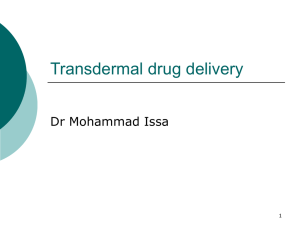Document 13309054
advertisement
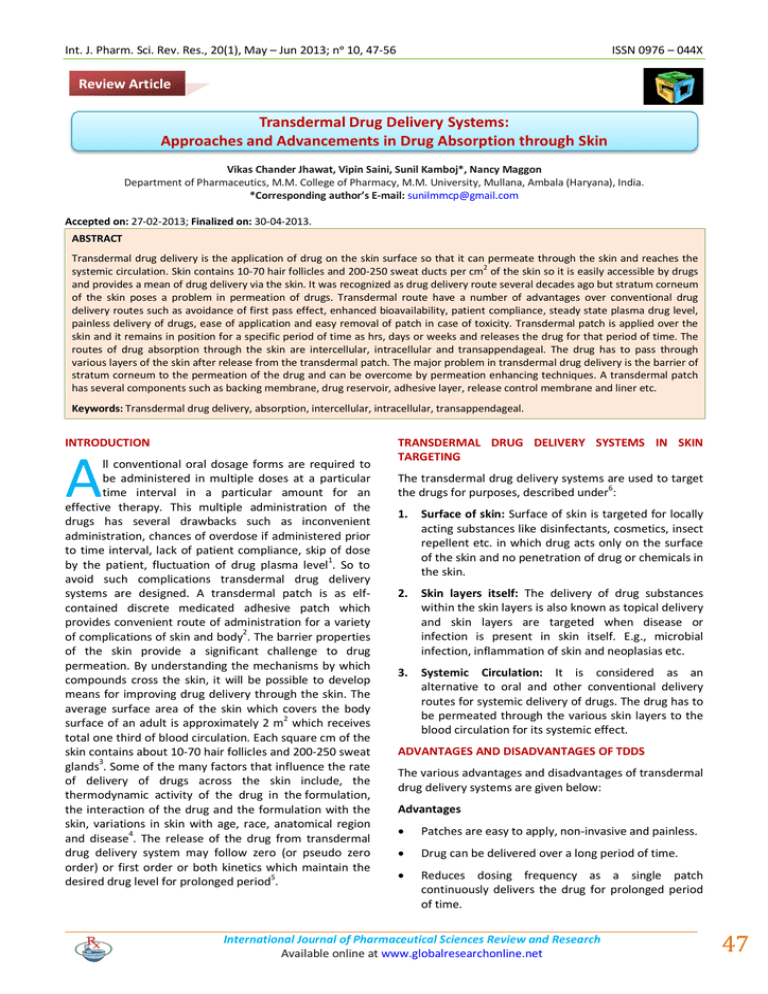
Int. J. Pharm. Sci. Rev. Res., 20(1), May – Jun 2013; nᵒ 10, 47-56 ISSN 0976 – 044X Review Article Transdermal Drug Delivery Systems: Approaches and Advancements in Drug Absorption through Skin Vikas Chander Jhawat, Vipin Saini, Sunil Kamboj*, Nancy Maggon Department of Pharmaceutics, M.M. College of Pharmacy, M.M. University, Mullana, Ambala (Haryana), India. *Corresponding author’s E-mail: sunilmmcp@gmail.com Accepted on: 27-02-2013; Finalized on: 30-04-2013. ABSTRACT Transdermal drug delivery is the application of drug on the skin surface so that it can permeate through the skin and reaches the 2 systemic circulation. Skin contains 10-70 hair follicles and 200-250 sweat ducts per cm of the skin so it is easily accessible by drugs and provides a mean of drug delivery via the skin. It was recognized as drug delivery route several decades ago but stratum corneum of the skin poses a problem in permeation of drugs. Transdermal route have a number of advantages over conventional drug delivery routes such as avoidance of first pass effect, enhanced bioavailability, patient compliance, steady state plasma drug level, painless delivery of drugs, ease of application and easy removal of patch in case of toxicity. Transdermal patch is applied over the skin and it remains in position for a specific period of time as hrs, days or weeks and releases the drug for that period of time. The routes of drug absorption through the skin are intercellular, intracellular and transappendageal. The drug has to pass through various layers of the skin after release from the transdermal patch. The major problem in transdermal drug delivery is the barrier of stratum corneum to the permeation of the drug and can be overcome by permeation enhancing techniques. A transdermal patch has several components such as backing membrane, drug reservoir, adhesive layer, release control membrane and liner etc. Keywords: Transdermal drug delivery, absorption, intercellular, intracellular, transappendageal. INTRODUCTION A ll conventional oral dosage forms are required to be administered in multiple doses at a particular time interval in a particular amount for an effective therapy. This multiple administration of the drugs has several drawbacks such as inconvenient administration, chances of overdose if administered prior to time interval, lack of patient compliance, skip of dose by the patient, fluctuation of drug plasma level1. So to avoid such complications transdermal drug delivery systems are designed. A transdermal patch is as elfcontained discrete medicated adhesive patch which provides convenient route of administration for a variety of complications of skin and body2. The barrier properties of the skin provide a significant challenge to drug permeation. By understanding the mechanisms by which compounds cross the skin, it will be possible to develop means for improving drug delivery through the skin. The average surface area of the skin which covers the body surface of an adult is approximately 2 m2 which receives total one third of blood circulation. Each square cm of the skin contains about 10-70 hair follicles and 200-250 sweat glands3. Some of the many factors that influence the rate of delivery of drugs across the skin include, the thermodynamic activity of the drug in the formulation, the interaction of the drug and the formulation with the skin, variations in skin with age, race, anatomical region 4 and disease . The release of the drug from transdermal drug delivery system may follow zero (or pseudo zero order) or first order or both kinetics which maintain the desired drug level for prolonged period5. TRANSDERMAL DRUG DELIVERY SYSTEMS IN SKIN TARGETING The transdermal drug delivery systems are used to target the drugs for purposes, described under6: 1. Surface of skin: Surface of skin is targeted for locally acting substances like disinfectants, cosmetics, insect repellent etc. in which drug acts only on the surface of the skin and no penetration of drug or chemicals in the skin. 2. Skin layers itself: The delivery of drug substances within the skin layers is also known as topical delivery and skin layers are targeted when disease or infection is present in skin itself. E.g., microbial infection, inflammation of skin and neoplasias etc. 3. Systemic Circulation: It is considered as an alternative to oral and other conventional delivery routes for systemic delivery of drugs. The drug has to be permeated through the various skin layers to the blood circulation for its systemic effect. ADVANTAGES AND DISADVANTAGES OF TDDS The various advantages and disadvantages of transdermal drug delivery systems are given below: Advantages Patches are easy to apply, non-invasive and painless. Drug can be delivered over a long period of time. Reduces dosing frequency as a single patch continuously delivers the drug for prolonged period of time. International Journal of Pharmaceutical Sciences Review and Research Available online at www.globalresearchonline.net 47 Int. J. Pharm. Sci. Rev. Res., 20(1), May – Jun 2013; nᵒ 10, 47-56 Suitable for drugs that are degraded in stomach pH, intestine or metabolized by liver as drug in TDDS avoids first pass metabolism by directly absorbing into the systemic circulation. ISSN 0976 – 044X transappendageal route occupies only 0.1% of total skin surface and therefore contributes a little11. b) Transcellular route No interaction of drug with food, enzymes, drink and other GI flora. Suitable for old age peoples who cannot take medicines orally. Suitable for drugs which are irritating by oral route and decreases drug side effects. In case of toxicity drug delivery can be stopped by removing the patch. Self-administration is possible. Patches are cost effective. Drug delivering through this route passes from corneocytes which has highly hydrated keratin creating hydrophilic pathway. Corneocytes are surrounded by lipids connecting these cells. So a drug requires a number of partitioning and diffusion steps. It is the most widely used route by various types of drugs. In transcellular route drug passes through the matrix (cytoplasm) of the cells. This route is suitable for hydrophilic drugs. The drug passes through the corneocytes of stratum corneum. The highly hydrated keratin provide aqueous pathway to the hydrophilic drugs. A number of partitioning and diffusion steps are needed to pass the drug through the cell 12 matrix . Reduces inter and intra patient variability c) Disadvantages Although Transdermal drug delivery systems possess numerous advantages but these also have some disadvantages as follow: Difficult to administer large dose i.e. more than 10 mg/ day. Ionic drugs create problems. Drugs having size more than 500 Dalton are not suitable for TDDS. Drugs in high concentration may cause skin irritation. Difficult to achieve high plasma drug concentration. Long term adherence creates discomfort to patients. Drugs with very low or high partition coefficient fail to reach systemic circulation7-10. Intercellular route As name indicates in intercellular pathway the drug diffuses through the continuous lipid matrix present between the cells. The barrier property of this route is due tortuous structure formed by corneocytes and the drug has to pass through the alternating lipid and aqueous domain by partitioning into the lipid bilayer and diffusing to the inner side. It has been found that water has to travel 50 times more by this route so; it is suitable mainly for uncharged lipophilic drugs12. PATHWAYS OF DRUG ABSORPTION THROUGH THE SKIN The drug can be absorbed by various pathways through the skin depending on the physicochemical properties of the drug. Both lipophilic and hydrophilic drugs are absorbed from different routes. The upper stratum corneum of the skin opposes the absorption of drug but presence of various absorption routes facilitates the entry of drug and transport of drug to the systemic circulation. Various drug absorption routes (figure 1) are as follows: a) Transfollicular route Transfollicular route is the shortest pathway that drug has to follow to reach the systemic circulation that provides a large area for diffusion of drugs. Skin has various sweat glands, oil glands, hair follicles and pores opening to the outer surface of the skin via their ducts. These ducts offer a continuous channel across the stratum corneum for drug transport but various factors like secretion from glands, content and amount of secretion etc., affect the transport of drugs through this route. However Figure 1: Skin showing route of absorption FACTORS AFFECTING TRANSDERMAL PERMEABILITY Various factors are involved in controlling and rendering permeability of drugs through the skin. These factors may be drug related or skin physiology related. Not only a single reason is responsible in affecting the permeation of drugs but a number of factors are involved which are mutually dependent on each other and are classified below: 1) Physiochemical properties of drug 2) Formulation characteristics 3) Skin physiology and pathology International Journal of Pharmaceutical Sciences Review and Research Available online at www.globalresearchonline.net 48 Int. J. Pharm. Sci. Rev. Res., 20(1), May – Jun 2013; nᵒ 10, 47-56 ISSN 0976 – 044X 1) Physicochemical properties of drug b. Ingredients of formulation The various physicochemical properties of drug which can alter the absorption and diffusion of drug through the skin are: Various excipients and polymers present in the formulation can affect either release of drug or permeation of drug through the skin by altering the 14 physicochemical properties of drug or skin physiology . a. Size of drug molecules and molecular weight Size of drug molecules varies inversely to the penetration through the skin. Drug molecules larger than 500 dalton creates problem in percutaneous transport. Greater the molecular weight smaller is the absorption. So size of drug molecules should not be so high that it creates problem in absorption13. b. Partition coefficient and solubility Drugs are either lipophilc or hydrophilic in nature. The partition co-efficient determine the solubility or diffusion of drug in lipids and aqueous systems. Drugs possessing both lipid and water solubility are suitable for percutaneous absorption as skin is made of lipid bilayer so drug should have some lipid solubility for absorption but at same time it should have some hydrophilicity to diffuse inside the skin in aqueous environment. So a drug candidate should have optimum partition co-efficient. The partition coefficient of a drug can be altered by changing the solvent system or by chemical modification in the structure of the drug candidate without affecting its pharmacological activity of the drug. c. Drug concentration The absorption of drugs through the skin is governed by passive diffusion. Drug moves according to concentration gradient i.e. from high concentration to low concentration. So the concentration of drug in the formulation applied over the skin determines the diffusion rate across the skin. Higher the concentration more will be the permeation. c. Presence of permeation enhancers Permeation enhancers of different categories are used to increase the permeation of drug through the skin. These alter the integrity of the skin (physicochemical and physiological modification) temporarily and open the skin pores for absorption. Permeation enhancer may be chemical substance which act chemically or physical permeation enhancer which physically interact with the skin integrity15. 3) Physiological and pathological condition of the skin The physiological and pathological conditions of the skin alter and affect the permeation of drug candidate through the skin by changing the properties of the skin. a. Hydration of skin Hydration of the skin causes the swelling of stratum corneum of the skin and provides some fluidity to the skin. Hydration also increases the permeant solubility and partitioning from vehicle to the membrane. So the permeation of drug molecules occurs easily through the hydrated skin5. b. Skin temperature On increasing the temperature of the skin the percutaneous absorption of the drug increases due to fluidization of lipids and vasodilation of the blood vessels which are in contact with the skin so increase in blood flow to the skin increases the absorption through the skin. d. pH conditions c. Skin age Most of the drugs are either acidic or basic in nature. So the pH of the drug molecule determines its ionization at skin surface. Unionized drugs or species have better absorption than ions or ionic species, so pH plays an important role in determining extent of penetration of drug. Transport of ionizable species in aqueous 14 environment is pH dependent . It is assumed that skin of young and elderly are more permeable than middle aged persons. In premature infants stratum corneum is absent and children are more susceptible to toxic effects of drugs through the skin. 2) Formulation characteristics The various formulation characteristics can also alter the permeation of drug molecule through the skin. These are as follows: a. Release rate of the drug The release of drug from the formulation is influenced by the affinity of the carrier for the drug in formulation and physiochemical properties of drug like solubility of drug in solvent and interfacial partitioning of drug from formulation to skin determines the release rate of the drug. d. Blood flow Changes in peripheral circulation do not affect transdermal absorption butan increase in blood flow increase the concentration gradient across the skin and reduces the total time of residence of the drug molecules in the dermis by continuously removing it. e. Pathology of the skin Disease of the skin and any injury to the skin causes the rupturing of the lipid layers of the stratum corneum which alters the skin penetration of drugs. Pathogens cause the disruption of skin layers by digesting them and can create pores in the skin so the integrity of the skin changes in both pathological conditions and in injury5. International Journal of Pharmaceutical Sciences Review and Research Available online at www.globalresearchonline.net 49 Int. J. Pharm. Sci. Rev. Res., 20(1), May – Jun 2013; nᵒ 10, 47-56 ISSN 0976 – 044X f. Regional Site of skin TYPES OF TDDS PATCH The skin differs in anatomical features such as thickness of stratum corneum, number of hair follicles and number of sweat glands per unit surface area. This difference may exist from site to site, person to person and species to species. So in all cases percutaneous absorption differs from one another16. 1. g. Skin flora and enzymes Various metabolizing enzymes and metabolizing microbes are present in the skin which metabolizes the drugs passing through the skin. Only a few drug candidates are there which reaches in active form in the circulation otherwise drugs are metabolized to various extents in the skin. E.g., 95% of the testosterone absorbed gets metabolized in the skin17. Reservoir system In reservoir systems the drug is enclosed between a rate controlling microporous or nonporous membrane and an impermeable backing laminate (figure 2). The drug is dispersed uniformly in solid polymer matrix and suspended in a viscous liquid medium making a paste. The release rate of the drug is determined by the abrasion rate, permeability, diffusion and thickness of the membrane. The release rate is zero order process from reservoir system. The whole system is supported on the impermeable metallic backing19,20. 18 KINETICS OF DRUG ABSORPTION The main mechanism by which the drug is absorbed through the skin is passive diffusion of drug through the skin. It means drug is absorbed according to the concentration gradient as high concentration of drug is present on the skin as compared to inside of the skin so drug molecules diffuses from reservoir to systemic circulation through the skin. The rate of drug absorption by passive diffusion is controlled by fick’s law of diffusion. The rate of permeation is dQ/dt is given by: dQ /dt = Ps (Cd - Cr) (1) Where Cd is the concentration of the in donor phase i.e., on the skin surface and Cr is the concentration of the drug in receptor phase i.e., inside the skin in systemic circulation. Pr is the overall permeability constant and is given by following equation: Pr = (KsDss/ hs) Figure 2: Reservoir system of drug delivery 2. Matrix diffusion system In matrix diffusion system (figure 3) drug is uniformly dispersed in hydrophilic or lipophilic polymeric material. The rate of erosion of the polymer, thickness of the layer and surface area of the film determines the release rate of the drug. No other rate controlling membrane is present in the matrix system. These are also known as the monolithic systems. Adhesive layer is spreaded around the circumference of the polymer disc instead of spreading on the surface of the patch21,22. (2) Where Ks is partition coefficient of the drug, Dss is apparent diffusivity of the drug and hs is thickness of the skin. So, permeability constant Ps may be considered as constant since Ks and Dss and hs (from equation 2) are constant under certain given set of conditions. So a constant rate of diffusion is achieved if Cd > Cr. So rate of diffusion dQ/dt in equation 1 can reduce to: dQ/dt = Ps. Cd (3) To maintain the permeation rate (dQ/dt) constant, Cd value should remain constant throughout the permeation process across the skin. To maintain Cd constant the drug release rate (Rr) should be always greater than absorption rate (Ra) i.e.,(Rr) > (Ra). So the concentration of drug on skin surface is always greater than saturation solubility of the drug in the skin (Ces) i.e.,Cd > Ces and a maximum skin permeation rate (dQ/dt)m is obtained: e s (dQ/dt)m = Ps. C Figure 3: Matrix diffusion system of drug delivery Matrix system of drug delivery can be modified by adding drug directly in the adhesive layer. This may be formulated in single layer drug in adhesive system or multilayer drug in adhesive system. 3. Drug in adhesive system In this system drug is dispersed in the adhesive layer of the patch (figure 4). The adhesive layer not only serves to adhere the components of the patch with the skin but also controls the rate of drug delivery to the skin. The adhesive layer is surrounded by the liner. In single layer patch a single drug in adhesive layer is present but in multilayer patch one layer is for immediate release of the (4) International Journal of Pharmaceutical Sciences Review and Research Available online at www.globalresearchonline.net 50 Int. J. Pharm. Sci. Rev. Res., 20(1), May – Jun 2013; nᵒ 10, 47-56 drug and other layer is for controlled release of the drug23. ISSN 0976 – 044X compatible with drug and other excipients of the formulation28,29. Various classes of polymers are used to formulate TDDS systems such as: Natural polymers: e.g.,zein, gelatin, shellac, waxes, chitosan, natural rubber, cellulose derivatives30. Synthetic polymers: e.g., PVA, PVC, polypropylene, polyacrylate, polyurea, polyamide, polyethylene, polyvinylpyrrolidone, PMMA31. Figure 4: Drug in adhesive layer system 4. Microresevoir system The micro reservoir system (figure 5) is the combination of the matrix and reservoir system. In micro reservoir system the drug is first suspended in an aqueous solution of a hydrophilic polymer (e.g., PEG) and then the above suspension is mixed with a lipophilic polymer (e.g., silicon) by high shear mechanical stirrer. The cross linking of the polymer chains produced in-situ stabilizes the micro reservoir system and a medicated polymer disc of 24,25 specific area and thickness is formed . Synthetic elastomers: polybutadiene, silicon rubber, hydrin rubber, nitril, acrylonitril, neoprene, butylrubber, polyisobutylene, polyurethane32,33. Biopolymers: Polylactic acid, collagen, xanthan, pullulane, elastin, gellan etc34. 3. Drug The drug should have some desirable physicochemical properties favorable for drug transport across the skin. Drug should have low molecular weight (up to 1000 dalton), low melting point, short half-life, affinity for lipophilic and hydrophilic, potent, and non-irritant35. 4. Adhesive COMPONENTS OF TDDS Adhesive maintains the patch in continuous contact with the skin. It should adhere to the skin with a finger pressure and should retain the patch in place for prolonged period. The selection criteria for patch include type and design of patch, adhesive properties. It should be non-irritant, compatible with the other ingredients of the formulation and skin and easily removable. E.g., polyisobutadiene, polyacrylate and silicon based adhesive polymer35. 1. 5. Figure 5: Microreservoir system Backing layer It protects the polymeric drug reservoir from the external environment, provides support to it and accepts printings. Backing membrane must have optimum elasticity, flexible and impermeable to drug diffusion to prevent drug loss. It should be compatible with polymer, excipients and drug and should not cause any reaction. It is fabricated of aluminium foil, polyethylene, polyester, polyvinyl chloride, heat sealed layers, polyurethane and includes adhesive foam pad26,27. 2. Polymer Polymer is the main part of the transdermal delivery systems. It is the properties of the polymer which determines and controls the drug loading, rate of drug release and adhesion of the patch to the skin properly. So polymer selection is the critical step for TDDS. Polymer matrix is formed when drug loaded polymer is sandwiched between a backing layer and laminate. The polymer should allow the incorporation of wide range of drugs in large amount and diffusion of the drug across the skin. Polymer used should be biocompatible with skin and Plasticizers Plasticizers provides flexibility and improves the brittleness of the polymer. These changes the physical and mechanical parameters of the polymer when added. These loosen the tight polymer linkage by joining themselves between the molecules of the polymer chains. Plasticizer (e.g., glycerol derivatives, phthalic acid esters, sebacic acid esters, oleic acid esters and alcohols) increases the elongation at break, toughness and flexibility of the polymer while decrease the tensile stress, hardness, electrostatic chargeability and glass transition 36 temperature . 6. Rate Controlling Membrane Rate controlling membranes determine the rate at which drug is to be delivered from dosage form. Various types of polymers from natural and synthetic origin are used to prepare a rate controlling membrane. E.g., chitosan, poly2-hydroxyethyl methacrylate37,38. 7. Release liner Release liner is the part of primary packaging and prevents the loss of drug from the polymer matrix and prevents contamination of the patch from outside International Journal of Pharmaceutical Sciences Review and Research Available online at www.globalresearchonline.net 51 Int. J. Pharm. Sci. Rev. Res., 20(1), May – Jun 2013; nᵒ 10, 47-56 environment during storage and transport. It is peeled off at the time of use. Release liner may be occlusive (e.g., polyethylene, PVC) or non-occlusive (paper fabric). Polyester foil and metallic foil are also used for release 39 liner . 8. Other excipients Various solvents such as methanol, chloroform, triethylcitrate, polyethylene glycol, propylene glycol etc. are used as permeation enhancers and to dissolve the 40 drug and polymers . ISSN 0976 – 044X 6. Percentage water vapour permeation (WVP) test Vials of equal diameter are used as permeation cell. The vials are washed and dried and then 1 g of fused calcium 2 chloride is taken in the cells. Now 1cm area patch is measured and fixed on the brim of the vial. The vials are weighed carefully and placed in the desiccator containing saturated solution of potassium chloride to maintain the relative humidity at 63%. After 72 hrs the vials are taken out and reweighed. The water vapour transmission is calculated as: WVP = W/S EVALUATION OF TDDS PATCHES 1. Thickness Thickness of the transdermal patch is measured by travelling microscope, dial gauge, screw guaze or micrometer at three different points of the patch and average of the three is taken as thickness of the patch a uniformly thick patch will have an equal thickness at every point. The variation of thickness within the patch and patch to patch can be calculated41,43. 2. Folding endurance 3. Percentage moisture content Individually weighed patches are kept in the desiccators having fused calcium chloride at room temperature for 24 hrs47,48. After 24 hrs the patches are to be reweighed and percentage moisture content is calculated by the formula: Percentage moisture content = (Initial weight-Final weight/Final weight) x 100 (5) 5. 7. Percentage moisture uptake Weighed films are placed in desiccator for 24 hrs and then exposed to 84% relative humidity using potassium chloride in a desiccator. The films are reweighed when attain a constant weight47,49. % Moisture uptake = (Final weight-Initial weight/Initial weight) x 100 (6) Drug Content The film of specific area and weight is dissolve in a suitable solvent such as methanol, phosphate buffer pH 7.4 and filtered. After making suitable dilutions drug content is find out by UV or HPLC method using standard curve53,54. Polariscopic examination This test is carried out to find out the physical form of the drug i.e. crystalline or amorphous form. A piece of the patch is placed on the slide and observed under the objective to determine the physical form of the drug particles55. 9. Weight uniformity The patches are dried at 60°C before weighing. The weight uniformity of the patch is measured by cutting and weighing the 1 cm2 piece of 3 patches and then calculating the weight variation. The mean of the 3 is taken as the weight of the patch. The individual weight should not deviate significantly from average weight45,46. 4. Where W is the water vapour transmitted in g/24 hrs and 50S is the surface area of the patch exposed in square cm 52 . 8. Folding endurance is calculated by continuously folding the strip of the patch /film of a specific area at the same place until it breaks or folded up to 300 times. The number of times of folding the patch without breaking gives the folding endurance of the patch. The folding endurance determines the flexibility of the patch44. (7) Flatness test Flatness test is performed to determine the smoothness of the film. Three strips of the film one from the center and two from the both sides of the film are to be cut and measured length wise. Variation in length is measured by finding out percent constriction. Zero percent constriction is considered equivalent to 100% flatness56,57. 10. Tensile strength To calculate the tensile strength the one end of the film is fixed on a support and other end is tied with a thread. Gradually increasing weights are placed over the thread. A pointer on the film gives the elongation of the film. The weight just at which film breaks is noted and tensile strength is calculated using the formula: Tensile strength = F/a.b (1+L/l) (8) F is the force required to break the film, a is the width of the film, b is the thickness of the film, L length of the film; l is the elongation of the film at break point58. 11. Shear adhesion test This test is applied to determine the cohesive strength of the adhesive polymer. The adhesive coated patch is applied over a smooth surface and a specified weight is hung to the patch parallel to the surface. The time it takes to pull off the patch from the surface gives its shear adhesion property. International Journal of Pharmaceutical Sciences Review and Research Available online at www.globalresearchonline.net 52 Int. J. Pharm. Sci. Rev. Res., 20(1), May – Jun 2013; nᵒ 10, 47-56 12. Peel adhesion test The force required to remove the patch from a surface is calculated in this test. The patch is applied on the surface 0 of a steel plate and is pulled away at 180 angle from the surface. The force required to pull off the patch is measured. ISSN 0976 – 044X and the animals are treated for 7 days according to their group. Animals are visualized every day for any itching and scar formation and graded according to visual inspection of irritation. After visual inspection animals are sacrificed and skin is tested histologically for any irritation and compared with formalin treated skin61. 18. In vivo study: The In vivo study involves: 13. Rolling ball tack test In this test a steel ball of 7/16 inch in diameter is rolled down an inclined having horizontally placed patch facing adhesive surface upward. The ball rolls down and runs horizontal distance on the patch. The distance run by the ball gives the tack property of the adhesive patch8,50,59. 14. Swelling property The patch is applied on a preweighed cover slip and weight is taken. Now it is place in a petridish containing 50 ml 7.4 pH phosphate buffer. At an interval of 5 minute the cover slip is removed from petridish, washed and weighed for 30 minutes. The change in the weight gives the swelling of the patch due to uptake of water. Percentage swelling (S) is given by: % S = (Xt-X0/X0) x 100 (9) Xtis weight at time‘t’ after swelling and X0is original weight of the patch53. 15. In vitro release study The In vitro release is determined using USP dissolution apparatus at 50 rpm, 37°C. Transdermal film is attached on a glass slide using an adhesive and immersed in the dissolution medium containing 900 ml of phosphate buffer pH 7.4. 5 ml sample is withdrawn at an interval of 1 hr for 24 hrs and equal volume of buffer is replaced in the dissolution medium. The sample is analyzed spectrophotometrically and cumulative drug release is calculated60. a) Animal model b) Human model Most preferably In vivo study is conducted on animal models as compared to human models because of easy availability of animals, ease of experiment and toxicity and safety parameters associated with the experiment. Various species of mouse, rat, dogs, monkey, pig, cat, rabbit and squirrel are used for animal study. Mainly hairless animal are preferred over hairy animals for transdermal formulation evaluation2. In final stage of formulation development human volunteers are studied to determine the pharmacokinetic and pharmakodynamic profile of the drug including safety and efficacy of the formulation. Clinical trials are conducted in IV phases. Phase I trials are conducted on small group of volunteers to determine the safety and toxicity profile. Phase II trials are conducted on a small group of patients for safety and toxicity for short term. Phase III study is conducted on a large group of patients and phase IV is the post marketing survey62. 19. Stability study Stability study is conducted to determine the time period for which the patch remains viable and usable. In unstable patch formulations drug starts degrading gradually so stability is tested according to ICH guidelines at 400C/75% RH for 6 months. Samples are taken at 0, 30, 60, 90 and 180 days and tested for its stability63. 16. In vitro skin permeation study ADVANCEMENT IN TDDS In vitro skin permeation study is carried out using vertical diffusion cell containing two chambers separated by the male wistar rat skin. The transdermal film is fixed on the rat skin and tied on the diffusion cell between the donor and receptor compartments. Samples are withdrawn at definite time interval and the fresh medium of equal volume is replaced. Samples are analyzed 61 spectrophotometrically and flux is determined . Human civilization has been applying substances as cosmetic and medicinal purpose for thousands of years. But the use of skin as a route of drug delivery was recognized in 20th century. Skin has some limitations in delivery of drug and cannot be used as a drug delivery route for all drug candidates. The continuous advancement in the science and technology is making the TDDS as the preferred and most convenient route for most of the drugs. The transdermal delivery is categorized into 3 generations according the advancements in TDDS64. 17. Skin irritation study Skin irritation study is performed on albino rats, mice or rabbits. The animals are divided into 5 groups each group having 6 animals. Group I is normal without any treatment, group II is control applied with marketed adhesive tape (USP official adhesive tape), group III is treated with transdermal patch without drug, group IV is treated with transdermal patch having drug, group V is treated with 0.8% v/v solution of formalin which acts as standard irritant. The hairs of animal skin are removed First generation It includes traditional patches having simple design. These include simple reservoir patches or matrix adhesive systems. These are composed of simple backing layer, rate controlling membrane, laminate and adhesive system. International Journal of Pharmaceutical Sciences Review and Research Available online at www.globalresearchonline.net 53 Int. J. Pharm. Sci. Rev. Res., 20(1), May – Jun 2013; nᵒ 10, 47-56 Second generation The second generation patches are having addition of permeation enhancers with simple patch. These permeation enhancers increase the drug delivery rate and amount of small lipophilic drug molecules through the skin. The permeation enhancer causes the irritation, damage or disruption of the skin to reverse its barrier property. Second generation patches includes chemical permeation enhancers, solvents, gentle heat and physical damage as the mean of permeation enhancement. Third generation The third generation patches are developed to permeate large hydrophilic drug molecules. Hormonal delivery through the skin patch become possible only by using latest techniques such as Iontophoresis, Sonophoresis, electrophoresis, Magnetophoresis and microneedle technique etc. These permeation enhancers forcefully allow the drug molecules to pass across the skin or physically damage the skin. ISSN 0976 – 044X analgesics, drugs of heart diseases, for avoiding GI effects and first pass metabolism. Because of a number of advantages and popularity of transdermal drug delivery systems, attracting the attention of researchers and going to introduce many new drugs in transdermal delivery form. The basic function of the skin is the protection of internal organs but applying drug via transdermal route may alter the physiology of the skin, so it should be kept in mind during designing the transdermal drug delivery system which alters the skin’s natural functions as least as possible. The better understanding of the skin physiology and anatomy helps us in further development in this field. But still a great knowledge and understanding of interaction of various polymers and skin components required to design and optimize the transdermal delivery. REFERENCES 1. Yadav V., AltafBhai M.S.,Mamatha Y.,Prasanth V.V., Transdermal Drug Delivery: A TechnicalaWriteup, Journal of Pharmaceutical and Innovation, 1(1), 2012, 5-12. 2. Valecha V., Mathur P., Syan N., Verma S., Various Penetration Enhancements Technique in Transdermal Drug Delivery, International Journal of Pharmacy and Technology, 3(2), 2011, 2373-2401. 3. Keleb E., Sharma R.K., Mosa E.B., Aljahvi A.Z., Transdermal Drug Delivery System-Design and Evaluation, International Journal of Advances in Pharmaceutical Sciences, 1, 2010, 201-211. 4. BhowmikD., Chiranjib, Chandira M., Jayakar B., Sampath K.P., Recent Advances In Transdermal Drug Delivery System, International Journal of PharmTech Research, 2(1), 2010, 68-77. 5. Ramteke K.H., Dhole S.N., Patil S.V., Transdermal Drug Delivery System: A Review, Journal of Advanced Scientific Research, 3(1), 2012, 22-35. 6. Brown M.B., Martin G.P., Jones S.A., Akomeah F.K., Dermal and Transdermal Drug Delivery Systems: Current and Future Prospects,Journal of Drug Delivery, 13, 2006, 175-187. 7. Sandhu P., Bilandi A., Kataria S., Middha A., Transdermal Drug Delivery System (Patches), Applications in Present Scenario, International Journal of Research in Pharmacy and Chemistry, 1(4), 2011, 1139-1151. 8. Patel D., ChaudharyS.A., Parmar B., Bhura N., Transdermal Drug Delivery System: A review, The Pharma Innovation, 1(4), 2012, 66-75. 9. Shingade G.M., Aamer Q., Sabale P.M., Grampurohit N.D., Gadhave M.V., Jadhav S.L., Gaikwad D.D., Review on: Recent Trend on Transdermal Drug Delivery System, Journal of Drug Delivery and Therapeutics, 2(1), 2010, 66-75. 10. Sharma N., Parashar B., Sharma S., Mahajan U., Blooming Pharma Industry With Transdermal Drug Delivery System, Indo Global Journal of Pharmaceutical Sciences, 2(3), 2012, 262-278. 11. Vyas S.P., Khar R.K., Controlled Drug Delivery-Concepts st and Advances, 1 Edition, VallabhPrakashan, 2002, 411445. FUTURE TRENDS IN TDDS In future transdermal route will be the most preferred for drug delivery because of greater patient compliance, controlled dosing, less frequency of dosing etc. Two decades ago nicotine patch were developed for smoking cessation for transdermal application and gained a very high popularity. After that many drugs were formulated in transdermal patch like nitroglycerin for angina, estradiol for estrogen deficiency, fentanyl for pain etc. Expiration of term of patents has encouraged the research scientists to formulate the drugs in new and acceptable dosage forms. Popularity of transdermal delivery system is further to continuously increasing as there are further improvements in design and technology. The leading pharmaceutical companies are working on TDDS and many techniques on transdermal route are patented by these companies and are working on these techniques for successful performance. Novel delivery systems such as liposomes, niosomes, nanoparticles, microspheres and micro emulsions are utilized to formulate TDDS for enhanced absorption and to increase the solubility of insoluble drugs. Other techniques of permeation enhancement are also developed such as use of mechanical energy to increase the drug flux across the skin either by altering the skin physiology or by increasing the velocity of drug molecules. Electrophoresis, iontophoresis, sonophoresis and magnetophoresis are the other techniques that have been investigated for improving the drug delivery across the skin for high molecular weight drugs as well as for insoluble drugs. In present scenario skin found to be the safest and most acceptable route of drug delivery to the systemic circulation, compared to oral route. CONCLUSION Transdermal drug delivery route is the safe and effective over other routes. Many drugs have been formulated in TDDS form, such as hormonal therapy, wide range of International Journal of Pharmaceutical Sciences Review and Research Available online at www.globalresearchonline.net 54 Int. J. Pharm. Sci. Rev. Res., 20(1), May – Jun 2013; nᵒ 10, 47-56 12. Morow D.I.J., Carron P.A. Mc, Woolfson A.D., Donnelly R.F., Innovative Strategies for Enhancing Topical and Transdermal Drug Delivery, The Open Drug Delivery Journal, 1, 2007, 36-59. 13. Prakash U R.T.,ThiagarajanP., Transdermal Drug Delivery Systems Influencing Factors, Study Methods and Therapeutic Applications, International Journal of Pharmacy, 2(2), 2012, 366-374. ISSN 0976 – 044X 28. Patel A.A., Trivedi D.G., Bhatt J.K., Shah D.A., Transdermal Patch: A Technical Note, International Journal of Pharmaceutical Innovations, 2(2),2012, 23-33. 29. Keith A.D., Polymer Matrix Considerations for Transdermal Devices, Drug Development and Industrial Pharmacy, 9, 1983, 605-625. 30. Tsai C.J., Hu L.R., Fang J.Y., Lin H.H., Chitosan Hydrogel As a Base for Transdermal Delivery of Berberine and Its Evaluation in Rat Skin, Biological and Pharmaceutical Bulletin, 1999, 22, 397-401. 31. Guy R.H., Current Status and Future Prospects of Transdermal Drug Delivery, Journal of Pharmaceutical Research, 13, 1996, 1765-1769. 32. Guy R.H., Hadgraft J., Bucks D.A., Transdermal Drug Delivery and Cutaneous Metabolism, Xenobiotica 7, 1987, 325-343. 14. Ansel’s Pharmaceutical Dosages Forms and Drug th Delivery Systems, 9 Edition, Walters Kluwer (India) Pvt. Ltd., 2011, 294-311. 15. Lombry C., Dujardin N., Preat V., Transdermal Delivery of Macromolecules Using Electroporation, Journal of Pharmaceutical Research, 17(1), 2000, 32-37. 16. Aulton M.E, Pharmaceutics, The Science of Dosage Form nd Design, 2 Edition, Elsvier Publisher, 2002, 499-533. 17. Kumar R., Philip A., Modified Transdermal Technologies: Breaking the Barrier of Drug Permeation via the Skin, Tropical Journal of Pharmaceutical Research, 6(1), 2007, 633-644. 33. Boretos J.W., Detmer D.E., Donachy J.H., Segmented Polyurethane: A Polyether Polymer, II, Two Year Experience, Journal of Biomedical Material Research, 5, 1971, 373. 18. Roberts M.S., Targeted Drug Delivery to the Skin and Deeper Tissues: Role of Physiology, Solute Structure and Disease, Clinical Experiment, Journal of Pharmacology and Physiology, 24(11), 1997, 874-875. 34. Khatri D., Sethi P., Anwekar H., Sharma A., Singhai A.K., Transdermal Drug Delivery System Based on Biopolymer: A Review, Inventi Rapid, PharmaTech 1(2), 2010, 1-7. 35. 19. Sharma N., Agarwal G., Rana A.C., Bhat Z.A., Kumar D., A Review: Transdermal Drug Delivery System: A Tool for Novel Drug Delivery System, International Journal of Drug Development & Research, 3(3),2011, 70-84. Jain N.K., Controlled and Novel Drug Delivery, First Edition, CBS Publishers and Distributors, New Delhi, 1997, 100-129. 36. Patani, G.A., Chien, Y.W., In, Swerbrick, J. and Boylon, J.C., Eds., Encyclopedia of Pharmaceutical Technology, Vol. 18, Marcel Dekker Inc., New York, 1999, 317-329. 37. Sun Y.M., Huang J.J., Lin F.C., Lai J.Y., Composite poly (2hydroxyethyl Methacrylate) Membranes As RateControlling Barriers for Transdermal Applications, Biomaterial, 18, 1997, 527-533. 38. Kandavilli S., Nair V., Panchagnula R., Polymers in Transdermal Drug Delivery Systems, PharmaTech, 1, 2002, 62-80. 39. Ahmed A., Karki N., Charde R., Charde M.,Gandhare B., Transdermal Drug Delivery Systems: An Overview International Journal of Biological Advances and Research, 2, 2011, 38-56. 20. 21. Joseph R.R., Vincent H.L.L., Controlled Drug Delivery, nd Fundamentals and Applications, 2 Edition, Revised and Expanded, Informa Healthcare, Replika Press Pvt. Ltd.,1987, 523-552. Wokovich A.M., Prodduturi, Doub W.H., Hussain A.H., Buhse L.F., Transdermal Drug Delivery System (TDDS) Adhesion as a Critical Safety, Efficacy and Quality Attribute, European Journal of Pharma and Biopharm, 64, 2006, 1-8. rd 22. Tyle P., Drug Delivery Device, 3 Edition, New York and Basal, Marcel Dekker, 2003, 417-449. 23. Arunachalam A., Karthikeyan M., Viney D.K., Pratap. M., Sethuraman S., Ashutoshkumar S., Manidipa S., Transdermal Drug Delivery System: A Review, Current Pharma Research, 1(1), 2010, 70-81. 40. Lalita K.L., Grampurohit N.D., Gaikwad D.D., Gadhave M.V., Jadhav S.L., Transdermal Patches: A Review, International Journal of Pharmaceutical Research and Development, 2011, 4(3), 2012, 96-103. Rao P.R., Diwan P.Y., Permeability Studies of Cellulose Acetate Free Films for Transdermal Use: Influence of Plasticizers, PharmaceuticaActaHelvetiae, 72, 1997, 4751. 41. Sankar V., Johnson D.B., Sivanand V., Ravichandran V., Raghuraman S., Velrajan G., Palaniappam R., Rajasekar S., Chandrasekaran A.K., Design and Evaluation of Nifedipine Transdermal Patch, Indian Journal of Pharmaceutical Sciences, 65(5), 2003, 510-515. 42. Baker R.W., Heller J., Material Selection for Transdermal Delivery Systems In,Hadgraft J, Guys R.H., Editors, Transdermal Drug Delivery: Development Issues and Research Initiatives, New York, Marcel Dekker, Inc, 1989, 293-311. 43. Verma P.R.P., Iyer S.S., Transdermal Drug Delivery of Propanolol Using Mixed Grades of Eudragit: Design and 24. 25. Walter M., Transdermal Therapeutic System (TTS) With Fentanyl as Active Ingredient, European Patent, EP 1418951, (2004). 26. Saroha K., Yadav B., Sharma B., Transdermal Patch: A Discrete Dosage Form, International Journal of Current Pharmaceutical Research, 3(3), 2011, 98-108. 27. Aggarwal G., Development, Fabrication and Evaluation of Transdermal Drug Delivery‐ A Review, Pharmainfo.net, 2009. International Journal of Pharmaceutical Sciences Review and Research Available online at www.globalresearchonline.net 55 Int. J. Pharm. Sci. Rev. Res., 20(1), May – Jun 2013; nᵒ 10, 47-56 ISSN 0976 – 044X in-vitro and in-vivo Evaluation, Drug Development and Industrial Pharmacy, 26, 2000, 471-476. 44. Shinde A.J., Garala K.C., More H.N., Development and Characterization of Transdermal Therapeutics System of Tramadol Hydrochloride, AAPS Pharmaceutical Science and Technology, 2(4), 2008, 265-269. 45. Das A., Ghosh S., Dey B., Das S., A Novel Technique for Treating the Type-II Diabetes by Transdermal Patches Prepared by Using Multiple Polymer Complexes, International Journalof Pharmaceutical Research and Development, 2, 2010, 195–204. 46. Ubaidulla U., Reddy M.V., Rukmani K., Ahmad F.J., Khar R.K., Transdermal Therapeutic System of Carvediol: Effect of Hydrophilic and Hydrophobic Matrix On in-vitro and in-vivo Characteristics, AAPS Pharmaceutical Science and Technology, 8(1), 2007, 212-216. 47. Gupta R., Bajpai M., Bhattacharya A., Formulation and in vitro Evaluation of Transdermal Drug Delivery System of Tizanidine Hydrochloride, Indian Journal of Pharmaceutical Sciences,7(4)2008, 208- 213 48. Kusum D.V., Saisivam S., Maria G.R., Deepti P.U., Design and Evaluation of Matrix Diffusion Controlled Transdermal Patches of Verapamil Hydrochloride, Drug Development and Industrial Pharmacy, 29(5), 2003, 495503. 49. 50. 51. 52. 53. Shaila L., Pandey S., Udupa N., Design and Evaluation of Matrix Type Membrane Controlled Transdermal Drug Delivery System of Nicotine Suitable for Use in Smoking Cessation, Indian Journal of Pharmaceutical Sciences, 68(2), 2006, 179-184 Pandey D., Akhilesh D.,Prabhakara P., Kamath J.V., Transdermal Drug Delivery System: A Novel Drug Delivery System, International Research Journal of Pharmacy, 3(5), 2012, 89-94. Raghavendra K., Doddayya H., Marihal S.C., Patil C.C., Habbu P.V., Comparative Evaluation of Polymeric Film of Transdermal Application, The Eastern Pharmacist, 43(516), 2000, 109-111. Dangi A.A., Sheth Z.P., Janki J., Formulation and Evaluation of Transdermal Ondansetron Hydrochloride Matrix Patch: In vitro Skin Permeation and Irritation Study, International Journal of Pharmaceutical Research and Allied Sciences, 1(2), 2012, 26-34. Patches, International Research Journal of Pharmacy, 2(1), 2011, 237-248. 54. Sahu R.K., Jain A., Nayak S., Development and Evaluation of Transdermal Patches of Colchicine, Der Pharmacia Lettre, 4(1), 2012, 330-343. 55. Lec S.T., Yac S.H., Kim S.W., Berner B., One Way Membrane for Transdermal Drug Delivery System, II, System Optimization, International Journal of Pharmaceutics, 77, 1991, 231-237 56. Chandrasekhar N.S., Hiremath S.R.R., Cytotoxicity, AntiTumor Activity, Cumulative Skin Irritation and Sensitization Study of 5-Flourouracil from a Transdermal Patch for Dalton’s Lymphoma Ascites Cells, Journal of Health Science, 53(3),2007, 275-281. 57. Swamy N.G.N., Dharmarajan T.S., Paranjothi K.L.K., Study of Film Forming Properties of hydroxy -propyl Guar and its use in the Medicated Transdermal Patches of Salbutamol Sulphate, Indian Journal of Pharmaceutical Education and Research, 42(2),2008, 147- 153. 58. Kulkarni R.V., Mutalik S., Hiremath D., Effect of Plasticizers on Permeability and Mechanical Properties of Eudragit Film for Transdermal Application, Indian Journal of Pharmaceutical Sciences, 64(1), 2002, 28-31. 59. Vishvakarma P., Aggrawal S., Sharma R., Sharma S., Transdermal Drug Delivery System: Review, International Research Journal of Pharmacy, 23(5), 2012, 50-53. 60. Sood A., Panchagnula R., Role of Dissolution Studies in Controlled Release Drug Delivery System, STP Pharma Sciences, 9, 1999, 157–168. 61. Panchaguinla, R., Transdermal Delivery of Drug, Indian Journal of Pharmacology, 29, 1997, 140. 62. Wester R.C., Maibach H.I., Percutaneous Absorption: Neonate Compared with Adult, In: Hunt M.K.D., Ed. Environmental Factors in human growth and development, Cold Spring Harbor, New York, Cold Spring Harbor Press, 1982, 3-15. 63. Wade A., Weller P.J., Handbook of Pharmaceutical Excipients, Washington DC: American Pharmaceutical Publishing Association, 1994, 362-366. 64. Ellen J.W., Three Generation: The Past, Present and Future of Transdermal Drug Delivery Systems, FreeCE, Pharmaceutical Education Cosutants, 2011, 1-22. Mandal S., Thimmasetty J., Ratan G.N., Kilarimath B.H., Formulation and Evaluation of Carvedilol Transdermal Source of Support: Nil, Conflict of Interest: None. International Journal of Pharmaceutical Sciences Review and Research Available online at www.globalresearchonline.net 56
